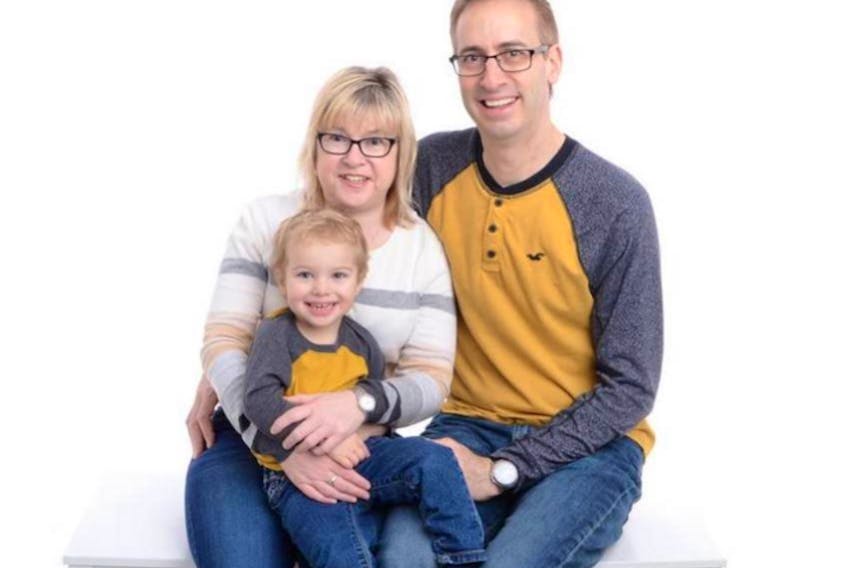ST. JOHN'S, N.L. — As Jackie Thomas describes the heartbreak of watching other moms take their kids to the park in her Cambridge, Ont., neighbourhood, her voice breaks.
"It's tough, you know," she said in a phone interview.
Besides the emotion in her voice, her speech is slowed by a rare condition — hereditary apastic ataxia — linked genetically to certain families originating from Newfoundland and Labrador.
But that is not the only symptom.
She has bad balance and currently walks with a cane, though she said she's getting a walker.
Thomas was only recently diagnosed after years of medical consultation and tests.
But while the diagnosis has solved a mystery, it also brought Thomas the realization there's little awareness of the condition and not much to grasp onto for advancements in treatment.
"It’s just debilitating. She can't play with our son like she wants to," said her husband, Steve Thomas, who met her 13 years ago.
For 11 of those years, the progression of Thomas's condition has been obvious.
"It’s just debilitating. She can't play with our son like she wants to." — Steve Thomas
"For years she was going to a neurologist, before she met me," he said.
"(The diagnosis) doesn't change any of her conditions, but now we kind of have a name to put to it. ... But we can't do much about it. There's no magic pill."
He does all the driving and shopping.
"He works every day to provide for me," Thomas said.
"Thirteen years ago, I met the love of my life. I was ready to call it in and move back home. He proposed to me and even before I said yes, I asked him, 'Will you do it on the Rock?' So, we got married there.”
The couple have a four-year-old son, Jacob, who is adopted and so isn’t at risk of developing the condition.
Thomas, who is from Winterton, Trinity Bay, has a goal to get the word out about the condition to others who may be suffering similar symptoms, unaware of their family history and risk for developing the condition.
Thomas said she had a pretty normal life, but over the years her mysterious symptoms worsened.
The situation may have been clouded by the fact that when she was 20, she was hit by a car on a crosswalk after getting off a bus in St. John's, where she was going to Memorial University.
"No one is as scared as me right now." — Jackie Thomas
She moved to Cambridge 22 years ago to join her sister, a nurse, in the mainland city.
Thomas's neurologist suggested she go see a neurologist specializing in genetics, who she saw in February. That specialist, through involvement in a research project, was familiar with the condition, and her results were positive.
Thomas said she has tried contacting other relatives to suggest they get tested.
“I think they are scared," she said. "No one is as scared as me right now. I think the more people become aware of it and get tested, the more geneticists can find out about it and possibly come up with a cure or treatment."
Managing disease
Dr. Kathleen Hodgkinson, who was involved in a project that revealed the genetic cause of hereditary apastic ataxia, said the condition is very obvious in its symptoms.
"It progresses, of course. It's not nice. Things just get worse,” she said.
“I do think with these sorts of diseases, good management is important."

According to Memorial University’s Gazette in 2012, the genetic cause of the disease was identified by researchers in Montreal, based on collaboration with researchers and clinicians at Memorial University's faculty of medicine.
The condition is characterized by lower-limb spasticity (or stiffness) and ataxia (lack of co-ordination), the latter leading to speech and swallowing problems, and eye movement abnormalities, the Gazette reported. People start developing gait problems between 10 and 20 years of age, walk with a cane in their 30s and, in the most severe cases, are wheelchair-bound in their 50s.
The disease had been recognized years earlier in Newfoundland and Labrador by Dr. Elizabeth Ives and Dr. William Pryse-Phillips, a neurologist responsible for many family members throughout the 1980s and 1990s, the article noted.
Hodgkinson assessed the families during the first years of her time in Newfoundland, expanding and digitizing family trees, collecting the phenotypic data and the DNA for the laboratory in Montreal, according to the Gazette.
Dr. Mark Stefanelli became the principal neurologist involved with family members.
The gene harbouring the mutation is VAMP1, encoding the synaptobrevin protein, and was discovered at the Guy Rouleau Laboratory in Montreal in collaboration with MUN researchers and others.
The scientific paper on VAMP1 in 2012 pinpointed the condition to three large Newfoundland families. In total, 50 members of those families were followed by the researchers. It is not life-threatening.
The burden of the disease can be dreadful, Hodgkinson noted, as patients worry about their progression and other family members being affected.
Hodgkinson said Pryce-Phillips and Stefanelli have done brilliant work in relation to the patients affected by VAMP1, but continued awareness is always a help. Resources are also needed.
“Good work has been done in Newfoundland and Labrador, and more needs to be done," she said.
Twitter: @BarbSweetTweets









